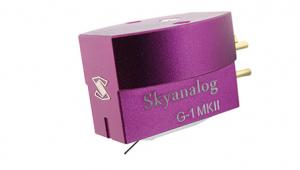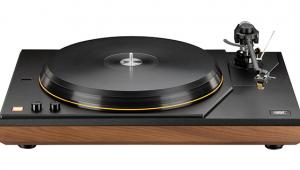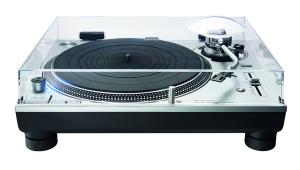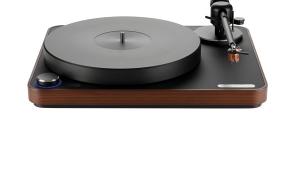Garrard 401 (Vintage)
The history of Garrard as a manufacturer can be traced back to World War One, when the famous jewellers to royalty wished to do ‘their bit’ for the wartime effort, ultimately setting up an ammunitions company. After hostilities ceased, the family was left with a small manufacturing plant in Swindon, which switched to the manufacture of wind-up motors for gramophones. From Tommy gun to turntables, one might say...
Skip forward to 1952 and Garrard launched the predecessor to the 401 – the 301. The 301 was the fi rst ‘transcription quality’ turntable launched in the UK to feature all three speeds plus a pitch control. Common to both the 301 and the 401 is a superb die-cast chassis and platter, massive motor, a quality idler drive and superbly engineered main bearing.
The 401 was launched in 1964, and was more a cosmetic upgrade than anything else with a re-styling from the pen of industrial designer Eric Marshall. But there were mechanical upgrades, including a stronger eddy current brake, the relocation of the mains power switch to below the chassis, ‘dish shape’ changes to the platter (some early 401s have a ‘flat’ 301 platter, like our sample) and the fitting of an upmarket neon strobe lamp.
Idler drive has been blamed in some circles for rumble and killing the sonics of these decks. While no drive system is perfect, in my experience this design bests many modern ‘slippy’ belt-drive systems. If the 401 has an Achilles’ heel it’s the plinth. Most turntables are supplied complete, and whatever you may think about colouredsounding wooden boxes or subchassis sonics, it does make life simpler! But if you seek the ultimate in performance, attention to the quality and construction of the plinth used is paramount.
SHEER POWER
For the purposes of the review, a simple wall-mounted open plinth was used. This was made from two layers of 24mm-thick strips of walnut, measuring 68x48cm (wd). The plinth was cut for a 12in arm, and both SME 3012 and Ikeda 407 arms were used with a mix of Ortofon SPU MC and Nagoka MP30 MM cartridges. For comparison, I used a similarly mounted Technics SP10/II.
Over the years I have spent time with a large number of modern high-end turntables. Yet I still come back to the superiority of this class of deck, whether it be direct or idler drive. From the minute the needle hits the groove there is a quality to the sound that can leave many other designs standing.
The first thing of note is the pitch and timing. It almost sounds as if these decks run fast; they do not of course, but neither do they smear dynamics in the way some enthusiasts report of more ‘up-to-date’ belt-drive decks. Then there’s the clarity in the bass. A strong chassis also helps in the bass department.
With such sturdy foundations to the sound, the Garrard is able to dig out a truly amazing performance. Classic vinyl tracks, such as Massive Attack’s ‘Unfi nished Sympathy’, took on an amazing persona, while a spin of some mid-’60s Stravinsky on Decca SKL amazed with its sheer power and flow.
On more subtle material the low levels of background noise were truly appreciated, but it was hard not to return to the more gutsy material. A very early 1958 DG stereo recording of Bach organ was immense, as was some more up to date pop stuff.
On audiophile-recorded direct masters and assorted Sheffield Labs material (we’re talking Kodo drums here) the sound was cavernous. What stands out with the Garrard is what it does not add. The heavy solid chassis keeps everything clean, taking away the minimum, and adding very little.
VERDICT
Demand for 401s has gone through the roof. Some 15 years ago you could find 401s for ‘sane’ money. Today expect to pay between £250 and £700 for a good clean chassis and much more for a decent plinth. Nevertheless, with a little work (on the plinth!) you’ll have one of the finest turntables out there.
Originally published in the Yearbook 2010

























































